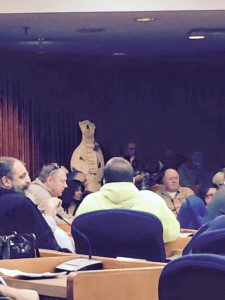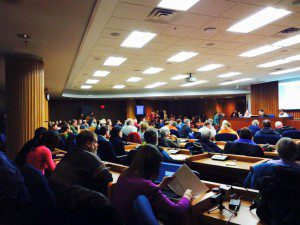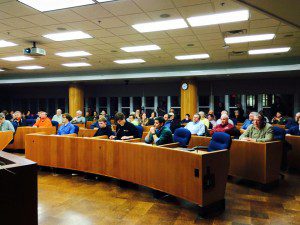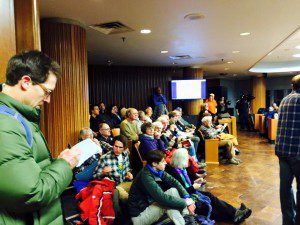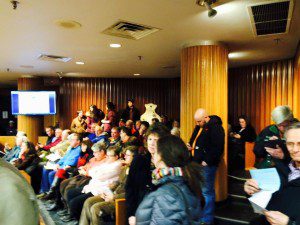No public input allowed, but it is a crowded house!
Crowded, waiting and won’t be able to speak
People are sitting on the floors, standing, and filling just about every space available including the floor of the board and the media and staff seats
Take a break
They dispensed with about an hour and 15 minutes of their agenda, then took a 10 minute break to count and sort the registration slips because there were so many. When they return from their break Patrick Miles, the chair of the Zoning and Land Regulation Committee says that there will be no public input but a chance for commissioners to debate and ask questions, however you can register as available to answer questions and committee members can ask questions.
Closed session
They noticed this to possibly go into closed session, some committee members want to do so. There are committee members that have conditions they want to seek legal advice on. He says he didn’t think they were going to go into closed session immediately. However, Mary Kolar moves to go into closed session, I missed who seconded it. They have a roll call vote and Miles, Matano, Kolar, Bolig and Salov vote yes and it is unanimous. They go into closed session, they remove themselves from the room to talk to their attorney as opposed to making the couple hundred people leave and they will be back. It was about 8:45 when they left. The meeting resumes at 9:35 and 90% of the people are still here. Still standing room only.
Here’s the audio of the rest of the meeting.
Return from closed session
Chair Miles announces that they are back in session. A community member asks if it is legal, he explains they can go into closed session for items that they might face litigation on and it was properly noticed. He says he knows there are strong feelings, but unless committee members have questions, they will not be taking public testimony. He asks them to respect their process working through the issues.
Staff Report and questions
Miles asks staff if there is anything new to report. Town action was taken before, they postponed at their last meeting, the Town of Medina approved with two conditions – one to increase the spill basin to a minimum of 60 minute flow which is about 2 million gallons of basin flow and a signed agreement for use of Town of Medina roads for any damage from construction machinery. At the last meeting on this subject the committee wanted more information and postponed, they asked for info regarding the 2006 DNR environmental assessment report, they requested documentation regarding proof of insurance in a catastrophic event, they also wanted to review the pipeline assessment to see if an environmental assessment was needed. Staff contacted the DNR, to see if the 2006 environmental report accounted for the upgrade to the line, it was confirmed that the report included the proposed increase in pressure., he attached the email. The Wis. DNR sent a letter to the Rock County Clerk dated December 23rd which outlines the environmental analysis the WI DNR has performed throughout the years. Enbridge submitted a letter dated January 6th with the risk assessment information, proof of insurance and includes a quarterly filing with the security exchange commission with $700M of sudden and accidental and pollution liability carried by Enbridge, there was also a letter from US department of transportation and pipeline hazardous materials safety administration that has approved approved Enbridges integrated contingency plan, the emergency response plan. It was approved July 11, 2013 and has a 5 year approval date. Staff is suggesting several conditions, be placed on the conditional use permit along with whatever the committee might have. (5:09) The first one is the pumping station be located and constructed as in the presented plans, Enbridge would be responsible for obtaining a road use agreement with the Town of Medina, the spill basin will be constructed to handle a minimum of a 60 minute flow prior to the operation of the pumping station, the pumping station shall be designed and constructed to limit the operating noise to a maximum of 80 decibels measured at the property line, exterior lighting shall be down-shrouded to limit light pollution to the adjoining properties. It is also suggested that to address concerns regarding spills that Enbridge would create $100M worth of liability insurance naming Dane County as an insured and indemnify Dane County.
Miles asks for questions of staff. Bolig asks the total insurance now and what is suggested? Staff says that they have $700M of sudden and accidental pollution liability, of that $100M would have Dane County exclusively named as an insured. Bolig wants to make sure that everyone understands that they aren’t building a new pipeline, they just want a pumping station to increase the flow in one of 4 lines that they own. The pressure will be increased, can you confirm the pressure rating that will be increased? Staff says that it was confirmed with Enbridge and the DNR that it is designed for a maximum 1,440 psi and the 1,275ppi is the maximum approved. Bolig asks if this is not approved or Enbridge decides they don’t want to build the pumping station, what will happen, will the tar sands still move through this line? Staff says there are 4 lines in Dane County, 3 lines are in operation, line 13 is a return path for diluent from the refineries to the northern terminals, the three other operating lines carry approximately 1.3M barrels a day, line 61 without this, with the increase of the 4 existing stations and the other 11 approved pumping stations, the pipeline would be increased to 1M barrels a day without that increase. Bolig says that the flow will continue with or without this pumping station. Staff says it currently is flowing. Bolig asks if neighbors are in approval of this pumping station, staff says the Town of Medina has approved this pumping station and we had found no objection from the 1 neighbor 600 feet away
Motion
Mary Kolar says that the CUP has 23 attachments, she reviewed them and she will make an effort to make a motion for committee discussion. She moves approval of the staff recommended conditions (11:58) with the additional conditions that Dane County be included as a named insured party of comprehensive environmental impairment liability (EIL) insurance purchased by the petitioner to ensure enough resources to cover complete clean up of a spill of crude or dilbit (for those who don’t know what dilbit is, it is diluted bitumen which is the tar sands that are currently going through but in case in the future it is crude oil, that is what she included both) within Dane County. The environmental impairment liability or EIL insurance policy should be written by an A or better rated insurance company, the insurance should be in effect for each year that Enbridge line 61 through Dane County is operated, the insurance policy shall have these coverage provisions: clean up expenses, bodily injury liability, property damage liability, natural resource damage and Dane County shall be named as an additional insured. The EIL policy should be primary and not contributory. An independent and properly credentialed body should evaluate the proposed retention area that is proposed for 2M+ gallons of spilled oil, which is one hours worth as planned by Enbridge, including public health requirements and air quality requirements that assess the health risks of such a potentially massive volume of airborne toxin and apply any and all appropriate federal air quality standards. An independent and properly credentialed body will assess the threat to surrounding wet lands posed by their proximity to the retention pond in the event of a major spill and Enbridge will make known to the proper county officials the composition of all dispersant agents used and planned to be used in the clean up of oil spills of particular concern in waterways. Composition of the dispersant shall include the proper name of each chemical in the dilutant, the proportion of each and the material safety data sheet or MSDS for each chemical provided.
The motion is seconded by Bolig. Miles asks if that is in writing for staff? She hands it to them. Miles re-reads the motion.
Questions of Registrants and Staff
(16:25) Kolar says that there has been a precedent for the committee to ask questions of the petitioner. They have 3 people registered to answer questions. Kolar asks to hear from someone that can speak to the insurance they have and potentially would have. Kolar says it is a lengthy motion, nothing is new information, but she would like to hear what insurance they have and what potential insurance they would have. Joel Cambric(?), Director of US Law for Enbridge says that they provided a list of insurance that they have to Assistant Attorney Gault last Thursday, he believes they have that, it is a comprehensive list of the categories of insurance they have, and the offer was for $100M of the $700M for Dane County to be additionally insured. Kolar asks if they provided the insurance providers? They provided the different categories of insurance that are covered, sudden and accidental pollution, general comprehensive insurance, etc. Kolar says he had a conversation they were not a party to and she asks if there are other items from that conversation that they should be aware of. He say no, they presented their position on the insurance to Atty Gault. They make what they submitted part of the record. Kolar asks what else he would like to share with them, he says that they have an indemnification to the county based on the operations of the pump station at issue and that can be entered into the record as well. Kolar hands him a paper, it has the motion that has been edited and she asked if the motion and the document that is labeled conditional use permit and liability indemnification and has insurance and security, not less that$100M per occurrance for bodily harm, property damage, limits of liability shall not be less than $2M per occurrance (he says that is for motor vehicle, the rest is subject to the $100M) are there shared purposes and vision in the motion and the document that they provided? He says that he thinks the document covers it, there may be some language clean up issues in terms of terminology, he thinks there is a commonality of purpose. Miles asks if the conditions are consistent with the motion and what Enbridge represented as discussed with Attorney Gault. Kolar made the motion with specifics, but she hadn’t seen the document shared with corporation counsel (what the hell were they doing in closed session?), she wants to make sure that the petitioner understands what the county is trying to do and that the county understands what the petitioner is trying to do. He says this is complex and before they start debating the motion, they should get their questions out of the way because he sees a distinction between what was made in her motion, EIL and the document provided to Atty Gault says commercial liability insurance.
(24:07) Miles asks the risk manager if there is a distinction between the two types of insurance? Risk Manager Dan Lowndes says that there is a commonality of ideas but the Kolar motion is very particular about a type of policy and the materials given to Atty Gault are more broad. If you are insuring a risk that is different than a type of policy, there is not a meeting of the minds. Enbridge is saying they have coverage that covers the same risk but it is not EIL, they have general liability with sudden and accidental which would cover the same risks, but it is not EIL, so we are not on the same page. Miles asks if EIL what is in general liability and more. Risk Manager says they cover different things, you have a general liability policy that has a pollution exclusion and then they have an exception to the exclusion for sudden and accidental pollution, like a chemical spill, that would be covered. EIL which was in the motion is more for storage tanks and leaking into the ground and that is not what this pipeline is, it is not a storage tank, so you are asking for a policy that does not fit the risks. Miles says this is something that might not be discovered immediately, its seepage, not a spill, not sudden and catostropic. Risk Manager agrees.
Kolar says that she understands a storage tank, but before us we have a federal law that leaves us no authority over a pipeline, but this is specific to a spill, isn’t it similar if a pipeline bursts or a tank leaks, there is still a foreign substance polluting the local environment. Risk manager agrees that the general concepts they are the same, but the specifics are not the same. Kolar says she thought that the EIL applies to tanks that leak. Risk Manager says yes, but there is not a tank that leaks in this project. Kolar says that the risk manager disagrees that a pipe burst and tank leak are the same. He says the end result is similar, but they type of insurance you have to get might be different.
(29:30ish) Al Matano asks 350 Madison, Peter Anderson, about the written testimony from January 24 and he says it seems the more we talk about insurance the less we know or the more confused we get. He says that their testimony says that Enbridge misrepresents the insurance they have. Anderson says that insurance is arcane, in the same way you went into closed session. You have to have an insurance expert who has done this at your side. He thinks there are details they might not be aware of. He thinks they need to bring someone in. He says if the facts were as Enbridge has told you, then sudden and accidental insurance, which doesn’t exist, it is general liability, if that were true, why are they in a lawsuit for an incident in 2010 when a 6 foot gash burst in Michigan, if that is covered under general liability, why are they suing to get paid. He says it is well understood that sudden and accidental is a prescription for litigation that goes on for decades. If you want to cover the ballpark, for all leaks, slow or long, sudden and accidental will have timeline on the occurrence to when it is reported. He doesn’t think a general liability insurance covers this. It is conventional wisdom to get EIL but you also need to get someone who is an expert in this, if they get EIL from a captive insurance, it might be someone internal to them, or frontal insurance and there might be under the table agreements to be paid back. He thinks the direction Kolar is aiming is right, but they need someone who knows the details.
(34:39) Matano asks about how you quantify the risks, we know that in Kalamazoo the cost of clean up is $1.2B, but that is just one data point, there are other incidents and clean ups. What kind of expert would they obtain to quantify the risk. Anderson says he is not the insurance expert, he says Eric Compass a professor at Whitewater can answer this better. He says that he has walked the site and there is no river, there is wetlands, but in terms of an environmental analysis and quantifying that ask the professor.
Matano asks about the different between claims made or occurrence based. Anderson says that is a critical difference, if it is claims made if you have a policy for 2015 and you don’t find out about the damages until 2017, the future time when you learned what happened is not covered, with occurrence based it would be covered.
Matano asks Eric Compas what kind of expert they need to retain to quantify the risk in terms of dollars of potential catastrophe. He says he teaches in a Geography and Geology department, but this is a little beyond his scope, he is not a specialist in this area, he says they should talk to some environmental remediation companies that will want to know the particulars of the site, and the contaminate and potential spill scenarios. Matano asks if the vendor would be one of the environmental companies or consultants for the DNR? Yes, but he couldn’t name a particular company.
(39:00)Matano says that there is a large audience and they are not used to it, the conundrum the have is that the conditional use process requires them not to have an opinion coming in to this and the idea that they are dancing around is that federal law pre-empts some of what we do, so the spill liability law pre-empts them on the issue of safety, its not true they can’t do anything, but they are trying to do is look at the liability issues since they can’t address safety so they are in the awkward position of saying once the environment is wrecked, how will we clean it up, that appears to be within our legal authority, but it is not within their legal authority to prevent the environment from getting wrecked in the first place. Which is a sorry place for them to find themselves.
Bolig wants to hear Enbridge’s remarks about the insurance, if they want. What kind of insurance to you have? He says he doesn’t know off the top of his head if it is occurrence based or claims based. He thinks it is occurrence based, he can confirm that if it is of interest. Bolig says it is of interest (laughter), if that were a condition do you see a problem with making that a condition. He says that they have an extensive insurance program and he isn’t sure what they can change without impacting the rest, and he wouldn’t want to change the entire insurance program for one issue, so he would hesitate to agree. Bolig asks if he has any other response to what he heard. He says the lawsuit is over a small portion of the insurance, the clean up of Kalamazoo wasn’t dependent on that insurance and their commitment to the cleanup did not waiver, they are seeking reimbursement.
(43:40) Kolar says that based upon the testimony they heard and her aversion to unintended consequences, she wants to change the first paragraph of her motion to petitioner should provide proof that they have an effective insurance policy for each and take out the reference to EIL, they should also provide proof that they have in effect a policy for each year that Enbridge line 61 runs through Dane County that is sufficient to cover complete clean up of a spill of crude or dilbit within Dane County and the insurance should be written by an A or better rated insurance company. You have a copy of her draft and she crossed out some language. The motion is seconded by Bolig, but the referral to the “right kind of insurance” needs to be clarified, can we do that? Kolar is concerned that if they make a condition that is so specific it will defeat the purpose of what they do, now that they heard about the different types of insurance she was keeping it braad, but she is open to suggestions. Bolig brings it up because he is not an expert and he never heard of occurrence based policy before tonight and if they leave it that way staff will insure we have the right kind of insurance.
Kolar says “or . . . ” Audience groans.
Matano asks Todd Vialante, Planning Director, if they were to retain an expert on insurance as recommended by Mr. Anderson what would that take? Violante says he would need to confer with the county purchasing agent to see if they can do a sole source and they would have to find out what dollar amount they are talking about, a larger dollar amount could be a more complicated process. Then they would need to find funding.
Matano says if they don’t resolve this tonight he would like them to work on that.
Miles asks if Matano is going to make a motion.
Motion to Postpone
(48:00) Matano makes a motion that they postpone action on the CUP to investigate the possibility of obtaining and insurance expert and getting an environmental assessment in terms of a risk assessment to determine the insurance needs for the situation. Miles restates the motion. Seconded by Miles.
Kolar asks if we would get insurance instead of Embridge, Matano says no, we would learn about insurance. Kolar was confused by how much, not what types. Miles and Matano explain they were talking about cost to get an analysis, staff says the same thing, cost to get outside consulting services.
No one seems to want to discuss. Miles supports the motion, agrees that they don’t like to postpone but uncomfortable requiring insurance when they don’t know what the amount needs to be and he was concerned with the language of the previous motion language about the pipeline being operated and the issue of occurrence based insurance, what if the pipeline isn’t operated and he thinks they need advise on the type of insurance they need, we are flying blind and he doesn’t think they should just say staff should do it.
Kolar asks Enbridge about the document they cited about insurance and its now a public record, she says that would stand including the postponement. Yes, they will not take that off the table, he says their insurance is mostly occurrence based, there is some claims based at the top of the insurance tower as you get to the higher limits, but the lion’s share is occurrence based.
The motion passes unanimously on a voice vote.
What next
Miles says it is postponed to a date in the future that is undetermined.
Salov asks what is next. Miles says they will get a report from staff after they consult with purchasing to get some idea the scale and cost of the analysis they are talking about and how it would be paid for. Miles asks if it is appropriate for the petitioner to bear the costs of the analysis. Salov says he was looking for a timetable, Miles asks Violante to answer that, they clarify what the motion was and what needs to be done. He says they can report back from purchasing by the committee work meeting on Feb. 10, but in terms of the process they will need to figure that out after talking to purchasing, they would need to craft a scope of services and take it a step at a time.
Miles says the earliest would be the next work session depending upon how much is on the agenda, if they have more than an hour of items he would like to not have people wait, that might limit this to a work session night instead of a public hearing night.
Salov asks if this might come back in terms of a resolution? A fund transfer to hire a consultant, he would encourage them to get that back to them so they can go to Personnel and Finance as soon as possible so they can make a decision on the CUP, so they can deliberate as quick as they can.
They adjourn.
The room remained crowded til the very end, I was quite impressed by that level of commitment by a large amount of people.

